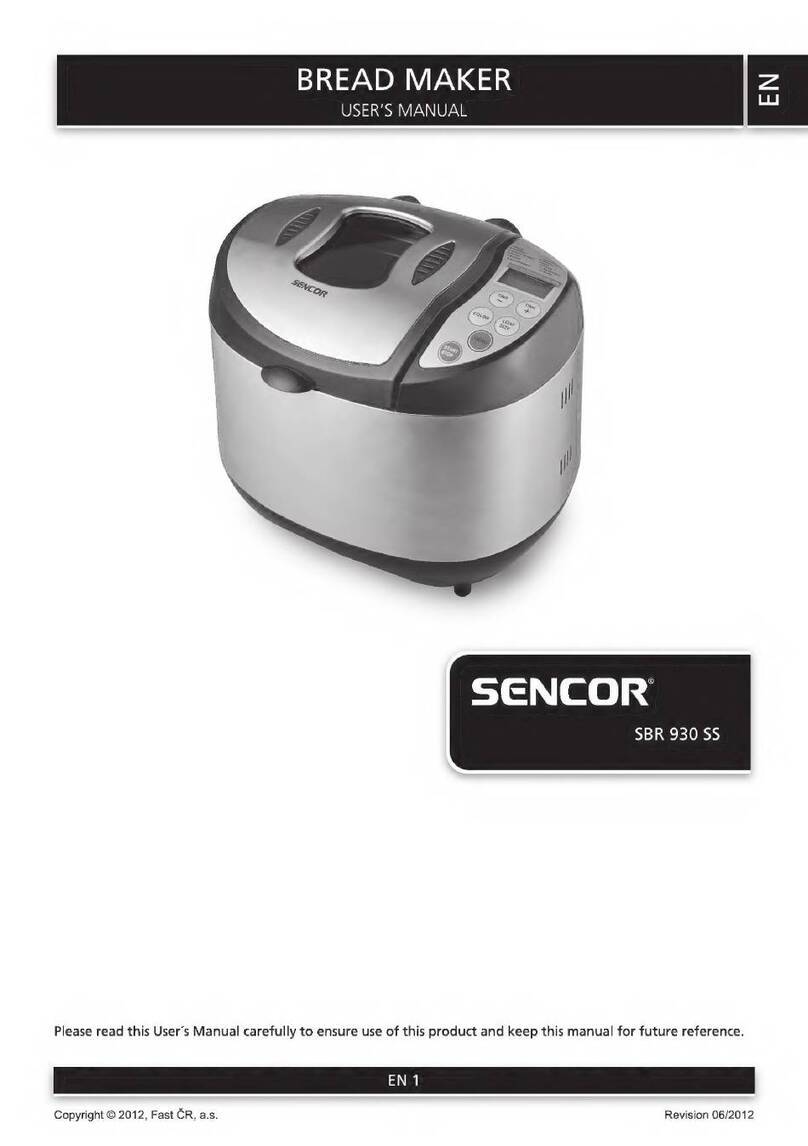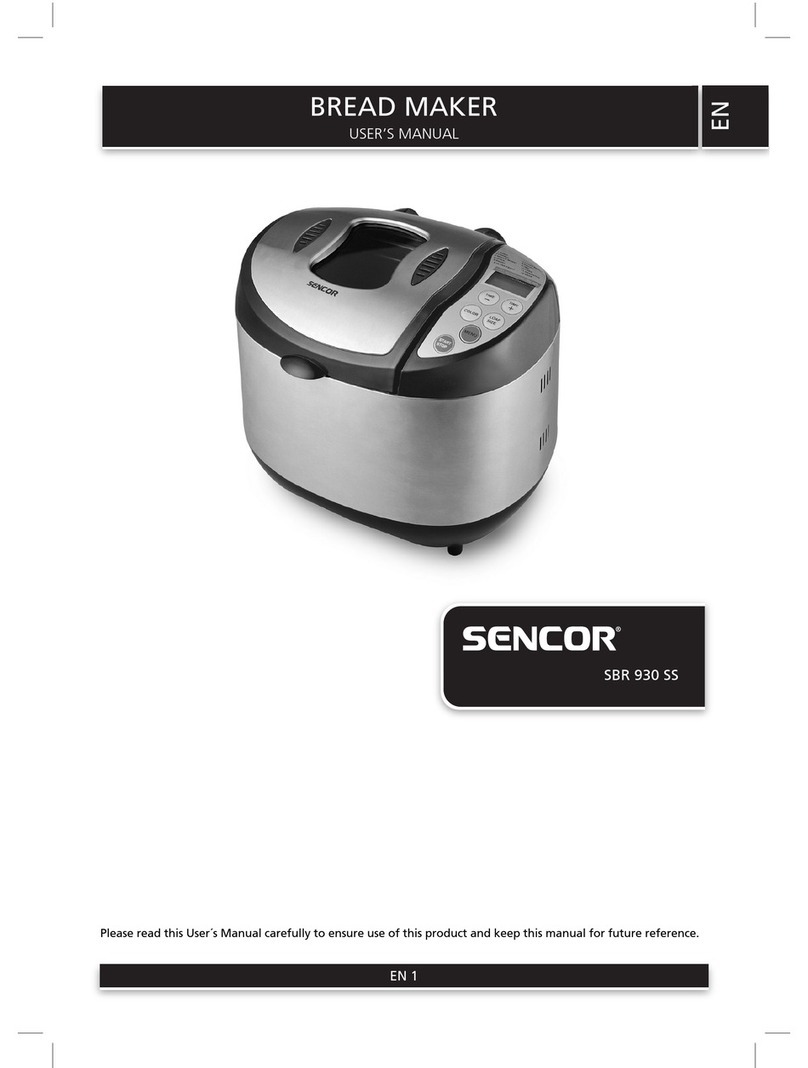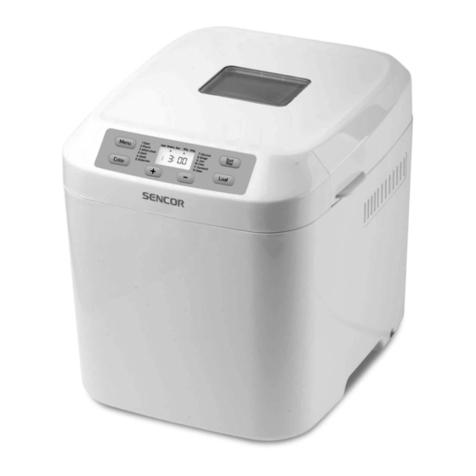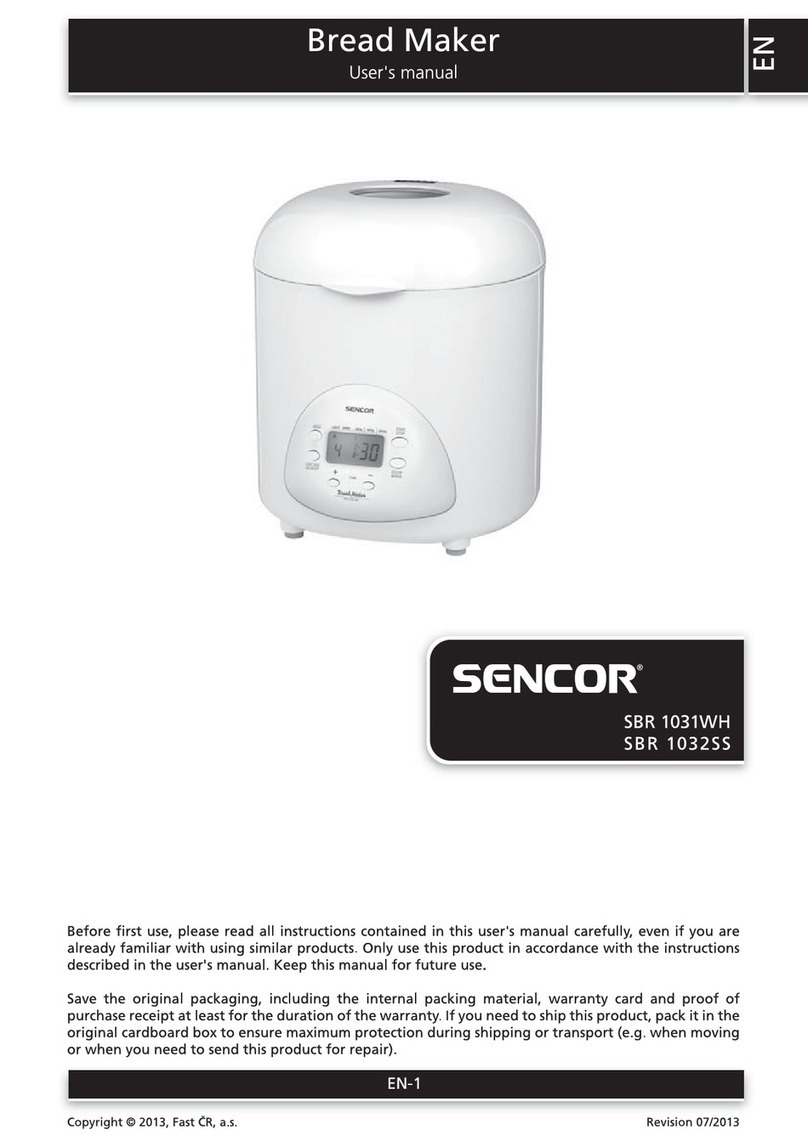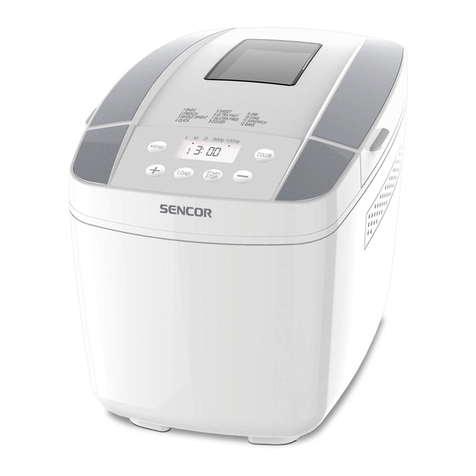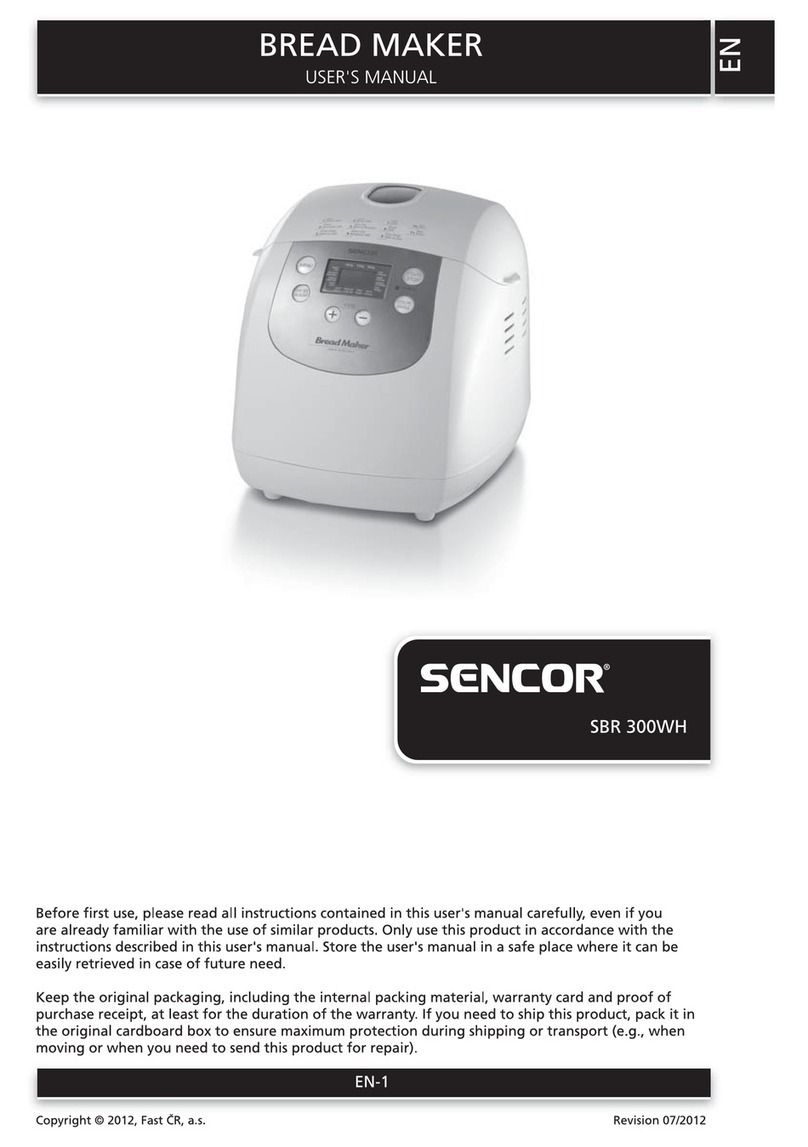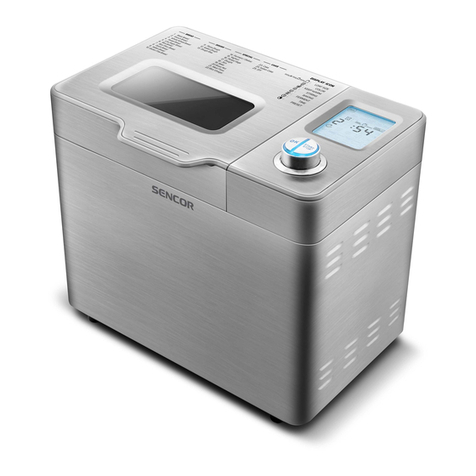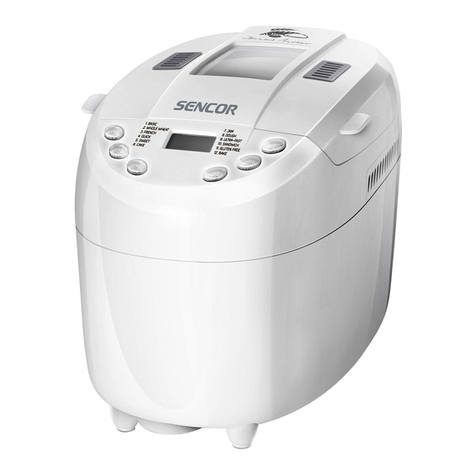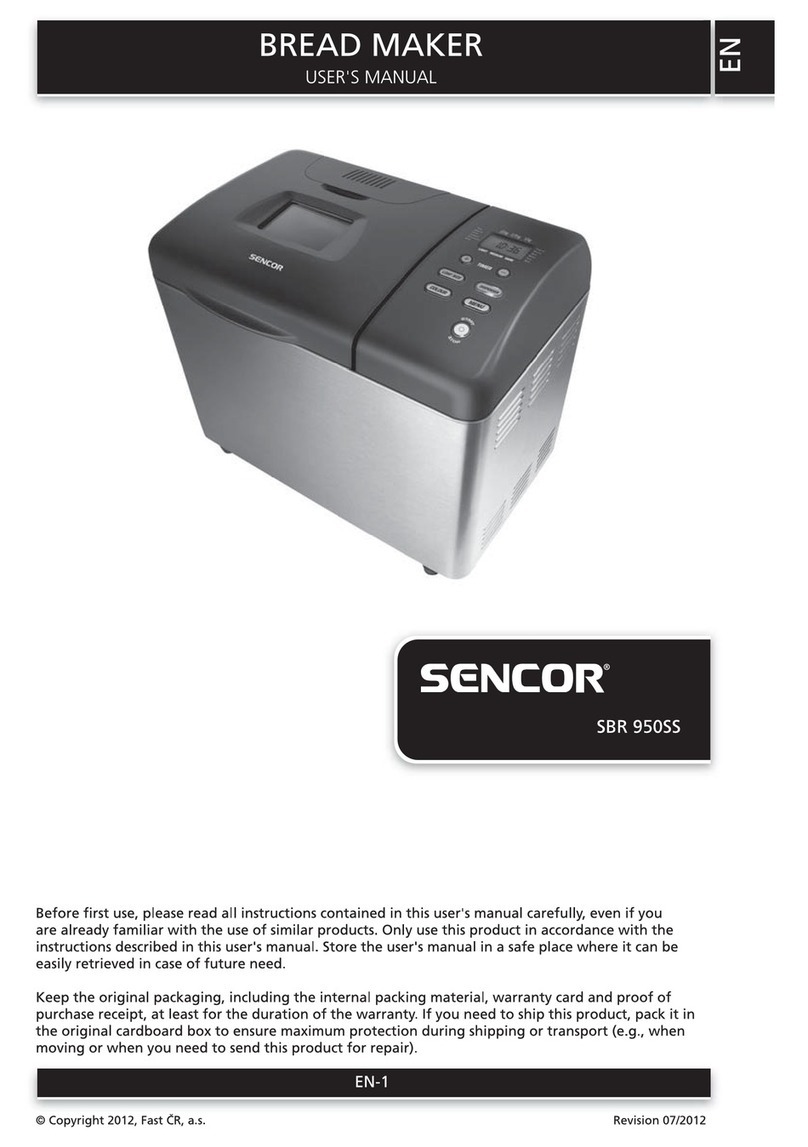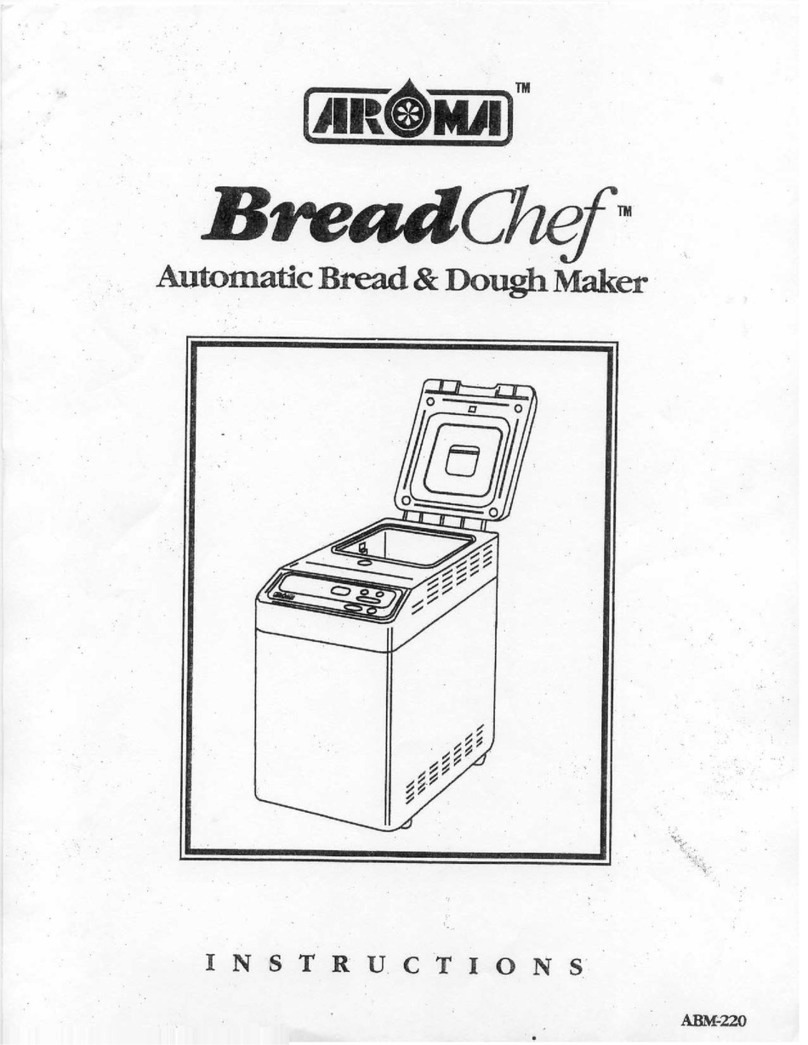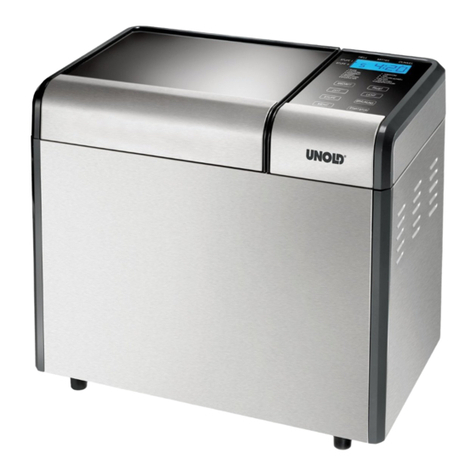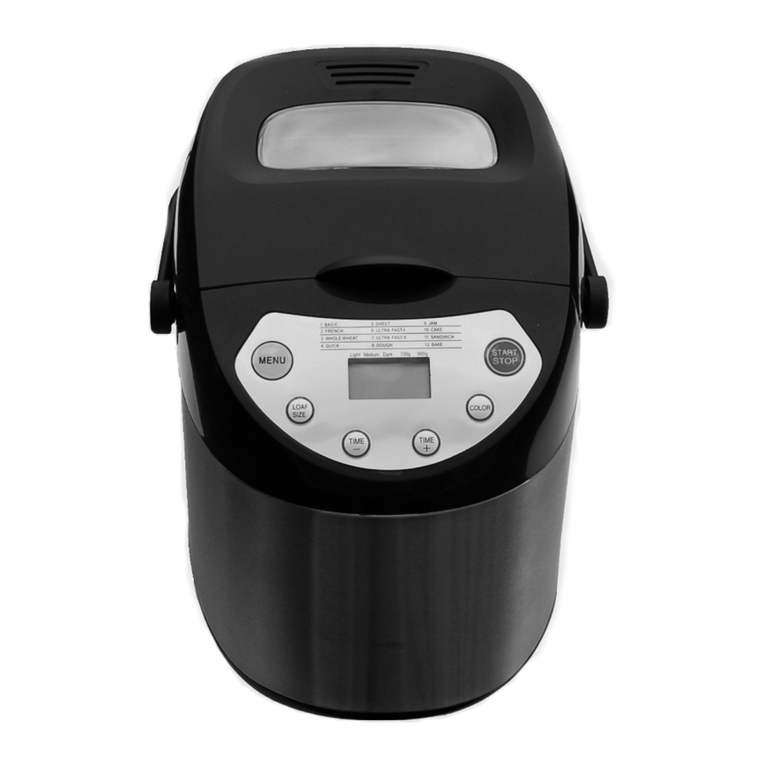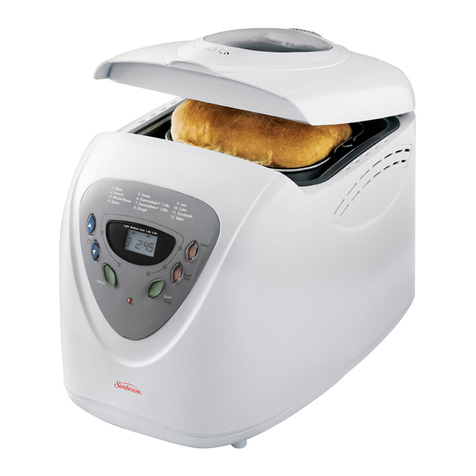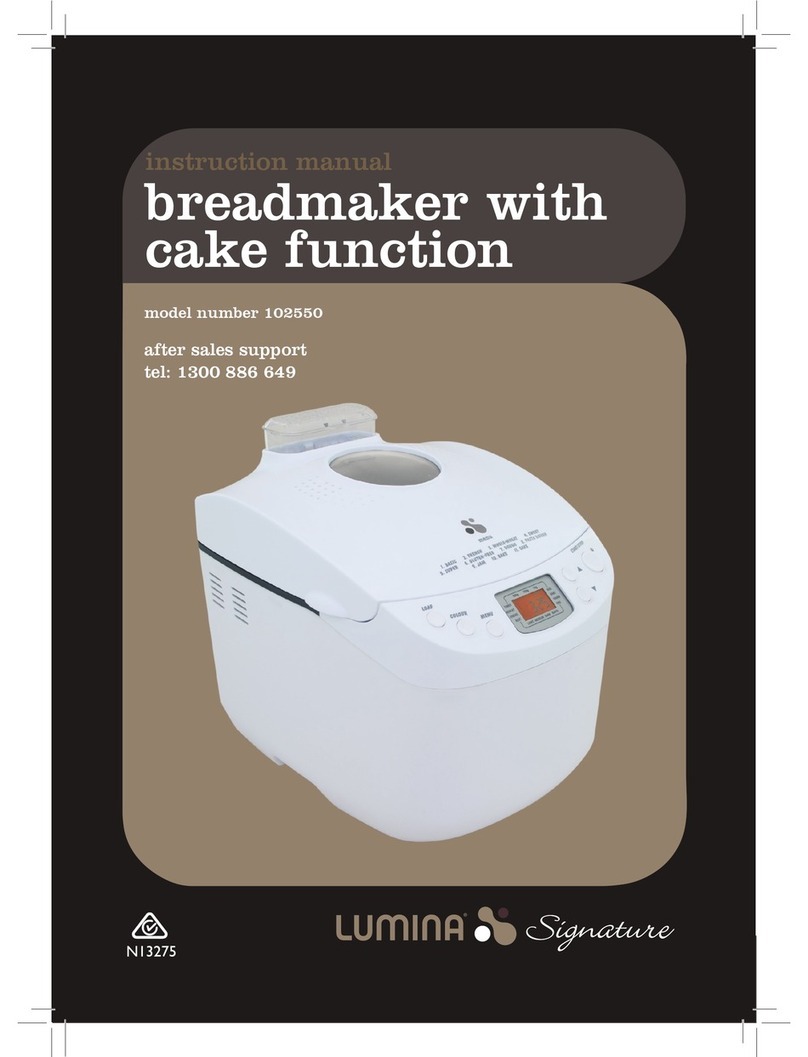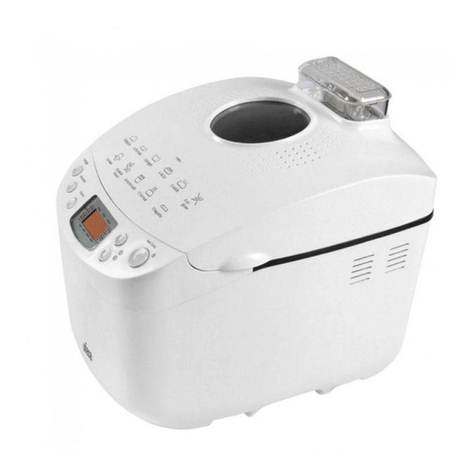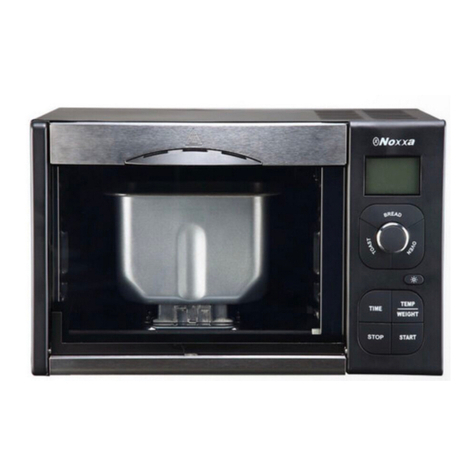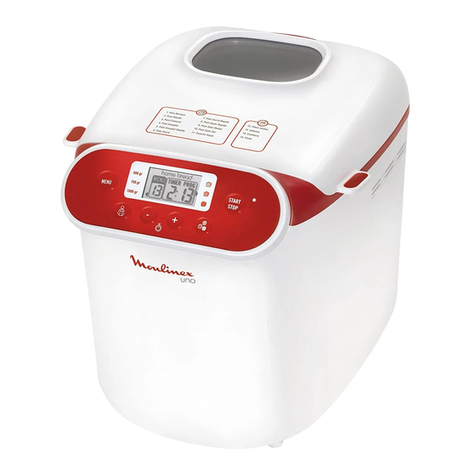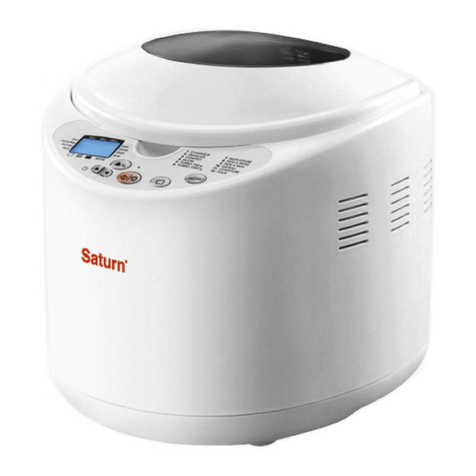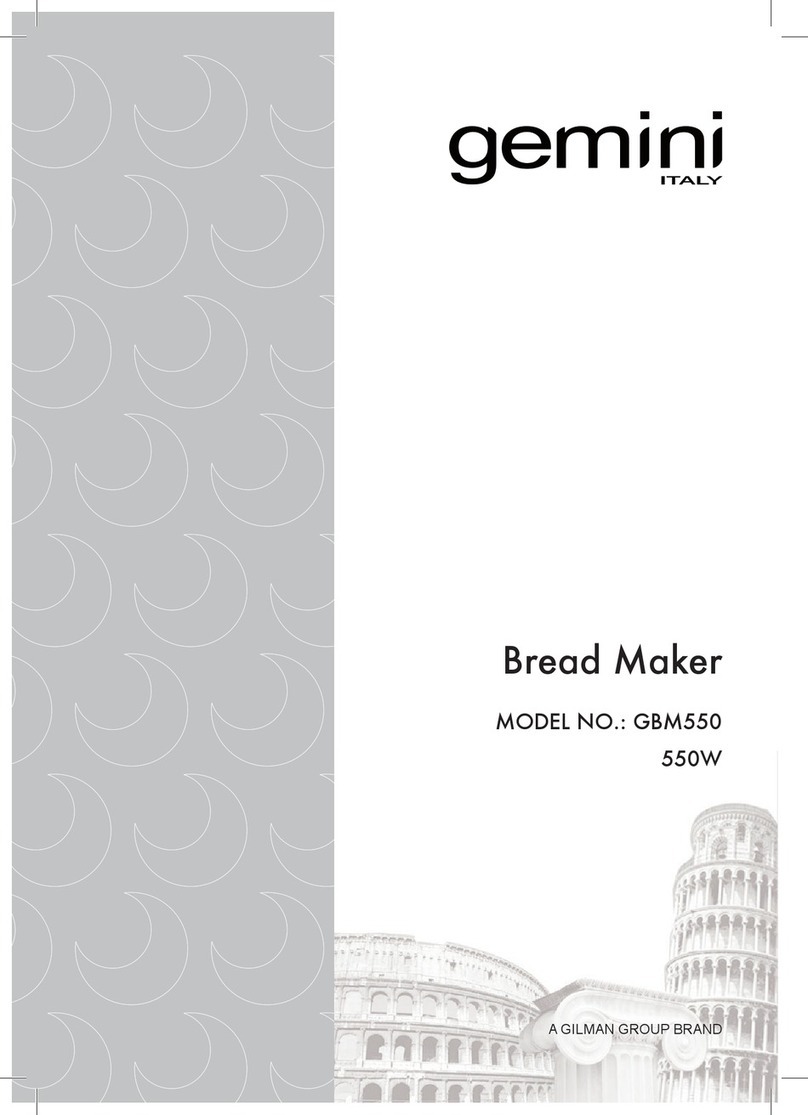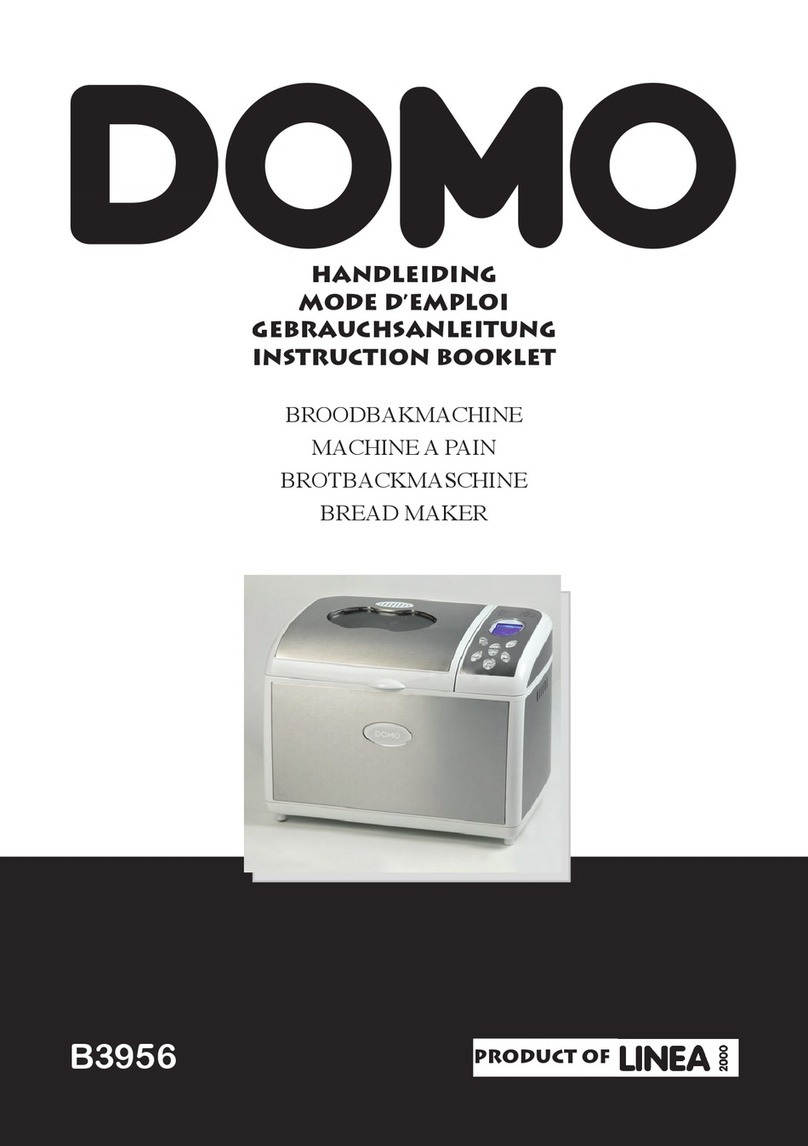
EN Breadmaker
User's manual
■ Prior to using this appliance, please read the user's manual thoroughly, even if
you already have experience in using similar appliances. Only use the appliance
in the manner described in this user’s manual. Keep this user's manual in a safe
place where it can be easily retrieved for future use.
■ We recommend saving the original cardboard box, packaging material, purchase
receipt and responsibility statement of the vendor or warranty card for at least
the duration of the legal liability for unsatisfactory performance or quality. In
the event of transportation, we recommend that you pack the appliance in the
original box from the manufacturer.
DESCRIPTION OF THE APPLIANCE AND
ACCESSORIES
A1 Lid handle
A2 Lid with viewing window
A3 Kneading blades
A4 Baking container with folding
handle
A5 Control panel with display
A6 Anti-slip feet
A7 Measuring cup
A8 Measuring spoon
A9 Kneading blade removal hook
DESCRIPTION OF THE CONTROL PANEL WITH LCD
DISPLAY
B1 Display
shows the selected program and
its length, set crust colour and loaf
size.
B2 "MENU" button
serves to set programs 1 to 12.
B3 "COLOR" button
serves to set the bread crust colour.
B4 "TIME+" button
serves to set the delayed start
timer
B5 "START/STOP" button
serves to start, pause and cancel a
set program.
B6 "LOAF" button
serves to set the loaf size: 2
lb (900g), 2.5 lb (1,130g), 3 lb
(1,360g) and"DOUBLE" (two
loaves). The "DOUBLE" loaf
size setting cannot be used on
breadmaker model SBR 2030WH.
B7 "TIME–" button
serves to set the delayed start
timer
Note:
The metric measuring unit is rounded down to whole tenths.
OPERATINGTHE BREADMAKER AND ITS FUNCTIONS
"MENU" button
■ Serves to select programs from 1 to 12. Each press of the B2 button is
accompanied by a short beep. The set program and its length is shown on the
LCD display B1.
"COLOR" button
■ Serves to set the crust colour to "LIGHT", "MEDIUM" or "DARK".The set bread crust
colour is shown on the LCD display B1.
■ It is not possible to set the crust colour in programs 6 – CAKE, 7 – JAM and8 –
DOUGH.
"LOAD" button
■ Serves to set the loaf size: 2 lb (900 g), 2.5 lb (130 g), 3 lb (360 g) and DOUBLE
(two loaves). The loaf size is understood to mean the sum of the weight of all the
ingredients placed in the baking container A4.The selected loaf size is shown on
the LCD display B1. The length of the program diers depending on the selected
loaf size as described in chapter Overview of programs and their lengths.
■ It is not possible to set the loaf size in programs: 6 – CAKE, 7 – JAM, 8 – DOUGH
and12 – BAKE.
Note:
The "DOUBLE" loaf size setting cannot be used on breadmaker model SBR
2030WH.
"TIME+" and "TIME–" buttons
■ Buttons B4 andB7 serve to set the delayed start timer.
■ Do not use this function with recipes containing ingredients subject to rapid
spoilage, e.g. fresh eggs, milk, sour cream, cheese, etc.
■ Heed the correct order for the addition of ingredients into the baking container
A4, as described in chapter Using the breadmaker. Yeast must not come into
contact with liquids prior to a program being started.
Example of a timer setting:
It is 9:00 p.m. and you wish to have a freshly baked bread at 8:00 a.m. the next day
(i.e. an 11-hour time dierence). First select the program, crust colour and loaf
size. Then use buttons B4 and B7 to adjust the time shown on the display B1 to
11:00. That is the time, after which the bread will be ready to be removed from the
breadmaker. Every time that buttons B4 or B7 are pressed, the time will be extended
or shortened by 10 minutes.To start the set program in the delayed start mode, press
the "START/STOP" button B5. Time will start counting down on the display. Regularly
check the breadmaker once the set program starts running.
Note:
The timer can be set to a maximum time of 13 hours.
"START/STOP" button
■ Serves to start, pause or end the set program.
■ To start the program press button B5 once. A short beep is made, the colon in
the time value on the LCD display B1 will start ashing, and the set program will
start running. When a program starts running, the other buttons are deactivated
to prevent potentially interrupting the currently running program phase.
■ You may pause the currently running program phase by short pressing button
B5. The countdown of the remaining time of the program will be paused and the
time value on the display B1 will ash. The setting will be stored in the memory
of the breadmaker. To resume the set program, press button B5 again. If you do
not do so, it will automatically be started 10 minutes after it was paused.
■ To end of the program, press button B5 and hold it down for approximately 2
seconds. The end of the program is signalled by a long beep.
"KEEP WARM" FUNCTION
■ When the program is nished, the breadmaker will automatically switch to
the keep warm mode for 60 minutes. If you wish to take the bread out of the
breadmaker without the subsequent keep warm function, cancel this function
by holding down the START/STOP button B5.
■ This function is not available for programs 6 – CAKE, 7 – JAM and 8 – DOUGH.
MEMORY FUNCTION
■ In the event of a short power outage (up to 10 minutes), the breadmaker will
automatically restart in the set program without the need to press the "START/
STOP" button B5 once power is restored.
■ In the event that the power outage is longer than 10 minutes, the paused
program will not be automatically resumed. If, however, the rising phase has
not yet commenced, you may start the program from the beginning. If the
rising phase has already commenced, it is necessary to start again with new
ingredients.
WARNING MESSAGES ON THE DISPLAY
1. If when the program is started, the text "H:HH" appears on the display
B1 accompanied by a sound signal, it means that the temperature inside
the breadmaker is too high. This may occur when you attempt to use the
breadmaker immediately after baking a loaf. Open the lid A2 and allow the
breadmaker to cool down for 10 to 20 minutes. Once it has cooled down, you
may use the breadmaker again.
2. If when the program is started, the text "L:LL" appears on the display B1
accompanied by a sound signal, it means that the temperature inside the
breadmaker is too low. Open the lid A2 and place the breadmaker into room
temperature. The recommended room temperature is 15 °C to 34°C.
3. If the text "EE0" or "EE1" appear on the display B1, please contact an authorised
service centre.
OVERVIEW OF PROGRAMS AND THEIR LENGTHS
1 – BASIC (basic bread types)
This program consists of the kneading, rising and baking phases. It is used for baking
standard types of bread from white wheat our that may be avoured using various
ingredients such as herbs, etc.
2 – WHOLE WHEAT (wholemeal bread)
This program consists of the kneading, rising and baking phases. It is used to bake
bread from wholemeal our.
Note:
We do not recommend using the delayed start function with this program.
Otherwise, the bread quality may be negatively aected.
3 – FRENCH (French style bread)
This program consists of the kneading, rising and baking phases, whilst the rising
phase is longer than on the basic program. It is used for baking traditional French
white bread with a uy centre and crispy crust. We recommend consuming French
style bread on the same day that it is baked.
4 – QUICK (quick baking)
This program consists of the kneading, rising and baking phases. This is a faster
alternative to program no. 1 – BASIC. A bread baked in this way has a less uy centre
than a bread baked with the basic program no. 1.
5 – SWEET (sweet bread)
This program consists of the kneading, rising and baking phases. It is used for baking
sweet bread with a higher fat and sugar content, and with the addition of dried fruit,
nuts, chocolate akes, candied orange peel, etc.
6 – CAKE
This program consists of the kneading, rising and baking phases. It is used for baking
cakes and sweet baked goods prepared from dough containing baking powder or
sodium bicarbonate.
7 – JAM
This program is used for making fruit marmalades and jams. Cook the marmalades
and jams in smaller batches as they increase in volume while being cooked. Jam is
sticky and is very dicult to remove if it escapes out of the baking container.
8 – DOUGH
This program is used for mixing and kneading ingredients and allowing the dough
to rise, e.g. for pizza, bread rolls, etc. It does not include the baking phase.
9 – ULTRA-FAST
Kneading, rising and baking bread as quickly as possible. Usually this bread is less
uy than the bread baked using program no. 4 – QUICK.
Water temperature is very important in this program. In order for the loaf to rise to
the required size, the temperature of the water or other liquid ingredients should be
in the range 48 to 50 °C.
10 – SANDWICH (toast bread)
This program consists of the kneading, rising and baking phases. It is used for baking
a uy toast bread with a thin crust.
11 – GLUTEN-FREE
This program consists of the kneading, rising and baking phases. Dough rises only in
a single phase and the baking time is longer due to its higher moisture component.
12 – BAKE
This program includes only the baking phase and makes your breadmaker into a
small oven. Baking time may be set in the range from 10 to 60 minutes. It is used for
baking ready-made dough from the store or for additional baking of a bread that has
just nished baking if you feel that its crust is too light.
Program Crust
colour
selection
Loaf size Length
of pro-
gram
Keep
warm
func-
tion
Time for
adding of
ingredi-
ents
Maxi-
mum
timer
setting
1 – BASIC light /
medium /
dark
3 lb (1,360 g) 03:10 60 min 2:30 13 h
2.5 lb (1,130 g) 03:05 60 min 02:25 13 h
2 lb (900 g) 03:00 60 min 02:20 13 h
Double 02:55 60 min 02:17 13 h
2 – WHOLE
WHEAT
light /
medium /
dark
3 lb (1,360 g) 03:50 60 min 03:05 13 h
2.5 lb (1,130 g) 03:42 60 min 03:00 13 h
2 lb (900 g) 03:34 60 min 02:52 13 h
Double 03:26 60 min 02:49 13 h
3 – FRENCH light /
medium /
dark
3 lb (1,360 g) 03:55 60 min 02:45 13 h
2.5 lb (1,130 g) 03:45 60 min 02:40 13 h
2 lb (900 g) 03:40 60 min 02:39 13 h
Double 03:35 60 min 02:36 13 h
4 – QUICK light /
medium /
dark
3 lb (1,360 g) 02:10 60 min 01:45 13 h
2.5 lb (1,130 g) 02:05 60 min 01:40 13 h
2 lb (900 g) 02:00 60 min 01:35 13 h
Double 01:55 60 min 01:32 13 h
5 – SWEET light /
medium /
dark
3 lb (1,360 g) 03:00 60 min 02:35 13 h
2.5 lb (1,130 g) 02:55 60 min 2:30 13 h
2 lb (900 g) 02:50 60 min 02:27 13 h
Double 02:45 60 min 02:23 13 h
6 – CAKE --- --- 01:48 --- 01:28 13 h
7 – JAM --- --- 01:20 --- --- ---
8 – DOUGH --- --- 01:30 --- --- 13 h
9 – ULTRA-FAST light /
medium /
dark
3 lb (1,360 g) 01:48 60 min --- ---
2.5 lb (1,130 g) 01:38 60 min --- ---
2 lb (900 g) 01:35 60 min --- ---
Double 01:33 60 min --- ---
10 – SANDWICH light /
medium /
dark
3 lb (1,360 g) 03:05 60 min 02:12 13 h
2.5 lb (1,130 g) 03:00 60 min 02:07 13 h
2 lb (900 g) 02:55 60 min 02:02 13 h
Double 02:50 60 min 02:00 13 h
11 – GLUTEN
FREE
light /
medium /
dark
3 lb (1,360 g) 03:55 60 min 03:18 13 h
2.5 lb (1,130 g) 03:50 60 min 03:13 13 h
2 lb (900 g) 03:45 60 min 03:08 13 h
Double 03:40 60 min 03:03 13 h
12 – BAKE light /
medium /
dark
--- 0:10 to
1:00
60 min --- ---
Attention:
The "DOUBLE" loaf size setting cannot be used on breadmaker model SBR
2030WH.
BEFORE FIRST USE
1. Take the breadmaker and its accessories out of the box and remove all packaging
materials from it.
2. Wash the accessories and removable parts intended for coming into contact
with food under warm running water using kitchen detergent. Then rinse them
under running water and dry them thoroughly with a wiping cloth.
3. Place the baking container A4 and the kneading blades A3 back in their place
inside the breadmaker. Connect the breadmaker to a power socket, set the
program 12 – BAKE and run the breadmaker empty in this mode for 10 minutes.
When the program ends, cancel the keep warm function and disconnect the
breadmaker from the power socket and allow it to cool down. Wash the baking
container A4 and kneading blades A3 again and dry thoroughly.
Note:
When rst turned on, there may be light smoke emitted. This is a
completely normal event.
4. Now, the breadmaker is ready for use.
USING THE BREADMAKER
■ Place the breadmaker on an even, dry and stable surface, e.g. on a kitchen
countertop.
■ Open the lid A2 and take out the baking container A4. Seat the kneading blades
A3 on to the shafts located at the base of the baking container A4, and push
them down thoroughly.
Note:
To make the removal of the kneading blades A3 from a baked bread
easier, we recommend coating the kneading blades A3 and shafts with
fat that can be heated.
■ Measure out the ingredients according to the recipe and place them into the
baking container A4 in the following order:
– First add all the liquid ingredients, such as water, milk, beer, buttermilk,
yoghurt, eggs, etc.
– Then add all the loose ingredients, such as our, salt, sugar, herbs, bread
spices, sprouts, akes, seeds, etc. Put the salt into one corner, and sugar into
another, and spices into another.
– Finally, make a hole in the middle of the our and put the yeast into it.. When
using fresh yeast, put the sugar in directly with it.The yeast or baking powder
must not come into contact with liquid before the breadmaker is started.
– With heavy, dense doughs with a high rye our component, in order to
achieve a better kneading result, we recommend that you reverse the order
for adding ingredients, i.e. rst add the yeast, then the our and the liquid at
the end. Also in this case it applies that the yeast must not come into contact
with liquid before the breadmaker is started.
– It is necessary to follow this general ingredient adding procedure for all the
recipes.
■ The room temperature of the area where the breadmaker is located may have an
eect on the nal size of the nished loaf.The recommended room temperature
is 15°C to 34°C.
■ Carefully place the baking container A4 with the ingredients into the
breadmaker and push it down properly so that it is rmly seated in the inner
area of the breadmaker. Close the lid A2 and connect the power cord to a power
socket. When it is connected to a power socket, a long beep will be made and
the default setting: program 1, program length 3:10 and loaf weight 3 lb (1,360
g) and crust colour "MEDIUM" will appear on the display B1.
Note:
If no button is pressed within 20 seconds, the back light of the display
B1 will turn o.
■ Use the "MENU" button B2 to set the required program. Use the "COLOR" button
B3 to select a crust colour and the "LOAF" button B6 to set the loaf size. Certain
programs do not enable the crust colour or loaf size to be set.
Attention:
The "DOUBLE" loaf size setting cannot be used on breadmaker model SBR
2030WH. This setting is only possible on models equipped with a double-
chamber baking container.
■ If you want your bread to be baked at a later time, set the delayed start timer
using buttons B4 and B7.
■ To start the breadmaker, press the "START/STOP" button B5. The colon in the
time shown on the display B1 will start ashing and the time remaining until the
end of the program will start counting down. The breadmaker will automatically
go through the individual phases of the program. Steam is emitted from the
ventilation openings during the baking process.
■ In programs: 1 – BASIC, 2 – WHOLE WHEAT, 3 – FRENCH, 4 – QUICK, 5 – SWEET,
6 – CAKE, 10 – SANDWICH and11 – GLUTEN FREE a sound is made to signal the
option to add ingredients. If you wish to do so, open the lid A2 and add the
ingredients, whilst being especially careful not to be scalded by the hot steam
coming out of the ventilation openings and the baking area.
■ When the program has nished, a sound will be made. Then the breadmaker will
switch to the keep warm mode for 60 minutes. If you wish to end the keep warm
mode, hold down the "START/STOP" button B5.
■ When the program has nished, tilt open the lid A2. Lift up the handle on the
baking container A4 and remove the baking container A4 from the breadmaker.
Wear kitchen gloves when doing all this. Place the baking container A4 on to a
heat resistant underlay and allow the bread to cool down for approximately 10
minutes while still inside. Then turn the baking container A4 upside down to
release the bread from it. If the bread does not come loose on its own, move the
shafts a few times. To take the blades A3 out of the bread, use the removal hook
A6.
■ When you have nished using it, disconnect the breadmaker from the power
socket and clean all the used parts according to the instructions contained in the
chapter Cleaning and maintenance.
Slicing and storing the bread
■ Allow the bread to cool down for 20–40 minutes before slicing it.
■ To cut slices of even thickness, use an electric knife or a sharp knife with a
serrated blade.
■ Wrap any unconsumed bread into a plastic bag. You may store it at room
temperature for up to 3 days.
■ If you wish to store the bread for an extended period (up to 1 month), place it in
a plastic bag or an air-tight container and the store it in a freezer.
■ Homemade bread does not contain any preservatives and therefore it cannot be
kept for as long as store-bought bread.
CLEANING AND MAINTENANCE
■ Prior to cleaning the appliance, disconnect it from the power socket and allow it
to cool down.
■ In the event that it is very dicult to remove the kneading blades A3 from
the shafts, ll the baking container A4 with hot water and allow it to act for
approximately 30 minutes. Then remove the kneading blades A3 and carefully
clean them using a dampened cloth and wipe it thoroughly dry.
■ Clean the baking container A4 from inside and out using a dampened cloth. In
order not to damage the non-stick layer, do not use sharp utensils, or cleaning
products with an abrasive eect. The baking container A4 must be completely
dry before being placed into the breadmaker.
Tip:
After cleaning, coat the kneading blades A3 including the hole in the
middle with cooking fat that can be heated.
■ Clean the lid A2 from inside and out using a dampened cloth. Then wipe
everything so that it is thoroughly dry.
Attention:
Brown stains may appear on the inner surface of the lid A2 and on the
ventilation openings.These are fume residues from the ingredients, which
exited together with the escaping steam. They have no damaging eect
on the material of the breadmaker or on the quality of the baked bread.
Simply remove these stains with a dampened cloth.
The surface of the baking container A4 may suer discolouration
after extended use. This, however, has no eect on the function of the
breadmaker or the quality of the bread.
■ Do not submerge the breadmaker in water or in any other liquid.
■ Before storing the breadmaker, make sure that it has cooled down, is clean and
dry, and that its lid A2 is closed.
BAKING BREAD
A short description of the most common ingredients used for baking bread
1) Bread our
Bread our has a large gluten content (therefore, we can also call it high-gluten
our containing a large amount of protein), has good elasticity and can rise
and retain the size of the bread without collapsing in on itself. Because it has
a higher gluten content than ordinary our, it can be used for baking larger
loaves. Bread our is the most important ingredient when baking bread.
2) Ordinary our
Ordinary our is made by blending thoroughly selected soft and hard wheat,
and it is suitable for quickly baking bread or cakes.
3) Wholemeal our
Wholemeal our is made by milling wheat and contains wheat bran and gluten.
Wholemeal our is heavier and more intensive than normal our. Bread made
from wholemeal our is usually smaller in size. Therefore, many recipes usually
combine wholemeal our and bread our in order to achieve the best possible
results.
4) Rye our
Rye our is intended primarily for baking dark breads. It contains a large
amount of mineral compounds. It has less gluten than wheat our and,
therefore, it is usually used in combination with wheat our.
5) Corn our and oatmeal
Corn our and oatmeal are made by milling corn and oats. Both these are
adjunct baking ingredients and are used to improve the taste and structure of
the bread.
6) Sugar
Sugar is a very important ingredient for achieving a sweet taste and bread
colour. White sugar helps the fermentation process.
7) Yeast
Yeast activates the fermentation process in the dough and produces carbon
dioxide, which helps the bread to increase its volume and to modify the inner
bres.
1 teaspoon of active dry yeast = 3/4 teaspoon of instant yeast
1.5 teaspoons of active dry yeast = 1 teaspoon of instant yeast
2 teaspoons of active dry yeast = 1.5 teaspoons of instant yeast
Yeast must be stored in a refrigerator as it would spoil at a high temperature;
check its use-by date before using it. Quickly return it to the refrigerator after
every use.
Tip:
Following the procedure described below, you may nd out whether the
yeast is fresh and active, or not.
1. Pour 1/2 a cup of warm water (45–50 °C) into a measuring cup.
2. Add 1 teaspoon of white sugar and mix it in, then sprinkle everything
with 2 teaspoons of yeast.
3. Place the measuring cup in a warm location for approx. 10 minutes. Do
not mix this mixture.
4. The foam must reach all the way to the edge of the measuring cup. If
not, the yeast is not active.
8) Salt
Salt is essential for improving the aroma of the bread and crust colour. Likewise,
salt slows down rising.
9) Eggs
Eggs may improve the structure of the bread, make the bread more nutritious
and larger, and give the bread a specic egg aroma. If you wish to use eggs, you
must remove the shells and mix it together evenly.
10) Fat, butter and vegetable oil
Fat can make the bread ner and extend its shelf-life. After being taken out
of the refrigerator, butter should be melted or cut into small parts so that it is
mixed in evenly.
11) Baking powder
Baking powder is used primarily for leavening when baking bread and cakes
in the Ultra Fast program. It does not need any time for fermentation and
generates a gas that creates bubbles and makes the bread structure ner.
12) Baking soda
The same applies as for baking powder. It can also be used in combination with
baking powder.
13) Water and other liquids
Water is an essential ingredient in breadmaking. It generally applies, that the
most suitable water temperature is 20–25°C. Nevertheless, for leavening in
accelerated programs, water should have a temperature of 48–50°C. Water may
be substituted for by milk or water mixed with a 2% milk powder, which may
improve the aroma of the bread and create a better crust colour.
■ Various types of our look similar, however the eectiveness of yeast or the
absorption ability of various types of our dier substantially depending on the
growing region, growth conditions, milling process and shelf life. For testing
purposes, select various our brands available on the market, taste it and
compare the results - then select the our that, based on your experience and
taste preferences, delivers the best results.
RECIPE TIPS
■ Please consider the ratios for weight and volume in all the provided recipes only
as informative in nature. Baking results depend on multiple factors:
– water hardness (when water that is too soft is used, the dough rises faster).
– air humidity (in the event of humidity, it is necessary to reduce the water
amount by 1–2 tablespoons)
– altitude above sea level (at over 750 m, the dough rises faster)
– consistency of the ingredients
■ For the above-mentioned reasons, we recommend that you adjust your recipe
based on the existing conditions.
■ A measuring spoon A8 and and measuring cup A7 are standard accessories of
the breadmaker. The measuring spoon A8 has a measuring spoon on each end
(large and small). Capacity of the small measuring spoon is 5 ml. Capacity of the
large measuring spoon is 15ml. The measuring cup A7 has a capacity of 250 ml.
■ One level measuring cup A7 is equivalent to 150g of our or 250ml of water.
■ One level small measuring spoon is equivalent to 6 g of salt, 3.5 g of dried yeast,
4.5 g of our improver, 3.5 g of cream of tartar or 6 g of baking soda.
■ One level large measuring spoon is equivalent to 14g of sugar, 7g of raisins, 6g
of nuts, 6.5g of dried milk, 16 g of oil. One whole egg weighs approximately 50
to 60 g.
■ When measuring out the ingredients, have the measuring cup or spoon placed
on a level surface. Check the exact liquid amount with the measuring cup or
spoon at eye level.
Tip:
If for whatever reason you do not wish to bake the bread according to
the recipe, you can purchase ready-made bread mixes at the grocery
store. With ready-made mixes, always proceed exactly according to the
instructions provided on the product's packaging. Also please take into
consideration that even such ready-made bread mixes sometimes require
yeast to be added separately.
Basic bread recipe
340ml of water
1 small measuring spoon of salt
3 large measuring spoons of white sugar
2 large measuring spoons of vegetable oil
3 ¾ measuring cups of bread our
2 ½ large measuring spoons of dried low-fat milk
2 small measuring spoons of our improver
1 ¼ small measuring spoons of dried yeast
Breadmaker settings: Program 1 – BASIC , loaf size: 900g, crust: as preferred.
Wholemeal bread
340ml of water
1 small measuring spoon of salt
2 ½ large measuring spoons of white sugar
1 ½ large measuring spoons of vegetable oil
1 ¾ measuring cups of wholemeal our
2 measuring cups of bread our
2 large measuring spoons of dried low-fat milk
2 small measuring spoons of our improver
1 ¼ small measuring spoons of dried yeast
Breadmaker settings: Program 2 – WHOLE WHEAT , loaf size: 900 g, crust: as
preferred.
French bread
340ml of water
1 ½ small measuring spoons of salt
2 ½ large measuring spoons of white sugar
1 ¼ large measuring spoons of vegetable oil
3 ¾ measuring cups of bread our
2 ½ large measuring spoons of dried low-fat milk
2 small measuring spoons of our improver
1 ¼ small measuring spoons of dried yeast
Breadmaker settings: Program 3 – FRENCH, loaf size: 900g, crust: as preferred.
Sweet bread
240ml of water
2 eggs
½ measuring cup of white sugar
½ small measuring spoon of salt
1 ½ large measuring spoons of vegetable oil
3 measuring cups of bread our
2 ½ large measuring spoons of dried low-fat milk
2 small measuring spoons of our improver
1 small measuring spoon of dried yeast
Breadmaker settings: Program 3 – SWEET, loaf size: 900g, crust: as preferred.
Cake
4 eggs
80ml of milk
1 large measuring spoon of melted butter
½ small measuring spoon of salt
2 ½ large measuring spoons of brown sugar
3 ¾ measuring cups of our
1 ½ small measuring spoons of cream of tartar (potassium bitartrate)
½ small measuring spoon of baking soda
2 large measuring spoon of dried yeast
Note:
First whisk the eggs separately and only then add them with the other
ingredients into the baking container.
Breadmaker settings: Program 6 – CAKE
TROUBLESHOOTING GUIDE TO BAKING
No. Problem Cause Solution
1. Smoke coming
from the
ventilation
openings while
baking
Certain ingredients are stuck
on the bottom heating
element or have come close
to it. Upon rst use, it may be
caused by oil residues on the
heating element.
Disconnect the breadmaker from
the power grid, allow it to cool
down, and clean the heating
element.
2. The bread centre
is collapsing.
The bread remained in the
breadmaker in the keep warm
mode for too long.
Do not leave the bread in the
breadmaker until the very end of
the keep warm mode.
3. It is very dicult
to remove the
bread.
The kneading blades A3 are
stuck in the loaf.
Move the shaft to release the loaf
from the baking container A4.
Then clean the baking container
A4 and the kneading blades A3
according to the instructions
in chapter Cleaning and
maintenance.
4. Ingredients are
unevenly mixed
and are baked
incorrectly.
1. Incorrect program selection Set the correct program.
2. You have opened the lid A2
several times after starting a
program.
Please do not open the lid A2
during the last rising.
3. The resistance during
mixing is too great, so
the kneading blade A3 is
almost not turning and not
kneading suciently.
Check that the kneading blades
A3 turn freely, then take out the
baking container A4 and start
the breadmaker without load. If
the appliance does not function
as usual, please contact an
authorised service centre.
5. The motor
is making a
noise but the
ingredients are
not being mixed
together.
The baking container A4 is not
correctly seated or the dough
is too bulky.
Check that the baking container
A4 is correctly seated and that
the dough has been prepared
according to the recipe and that
the ingredients have the correct
weight.
6. The bread is so
large that it is
pressing against
the lid A2.
Too much yeast, our or water,
or the ambient temperature
is too high.
Check the described factors,
reduce the amount of
ingredients in an appropriate
manner.
7. The bread is too
small or leavening
did not occur.
No yeast or an insucient
amount of yeast, or the
yeast is not active due to
an excessively high water
temperature, or the yeast was
mixed together with the salt,
or the ambient temperature
is too low.
Check the amount and activity of
the yeast, move the breadmaker
to an appropriate room
temperature.
8. The dough is
too bulky and is
owing out of the
baking container
A4.
Excessive amount liquids
causing the dough structure to
be too ne, or too much yeast.
Reduce the amount of liquids
and yeast.
9. The bread falls
apart in the
middle.
1. Inappropriate our or a our
with an expired use-by date.
Use the correct type of our and
check its use-by date.
2. Too much water makes the
dough too moist and ne.
Modify the amount of water in
the recipe.
10. Bread structure is
too dense.
1. Too much our or not
enough water.
Reduce the amount of our or
increase the amount of water.
2. Too many fruit ingredients or
too much wholemeal our
Reduce the amount of the
respective ingredients and
increase the amount of yeast.
11. Bread centre is too
porous.
1. Excessive amount of water
or yeast, or the salt is
missing.
Reduce the amount of water or
yeast as appropriate, and check
that salt was added.
2. Water temperature is too
high.
Check the water temperature.
12. When baking
cakes or baked
goods with a
large amount of
sugar, the crust
is too strong and
the crust colour is
too dark.
Various recipes or ingredients
have an eect on the nal
result; the crust colour is dark
because of a large amount
of sugar.
If a recipe containing a large
amount of sugar results in the
crust colour being too dark, end
the program 5 to 10 minutes
before the automatic end of the
program. Before taking it out,
you should leave the bread or
cake in the baking container A4
for approximately 20 minutes
with the lid A2 closed.
TECHNICAL SPECIFICATIONS
Rated voltage range..............................................................................................................220−240 V
Rated frequency................................................................................................................................50 Hz
Rated power input..........................................................................................................................850 W
We reserve the right to change text and technical specications.
INSTRUCTIONS AND INFORMATION REGARDING
THE DISPOSAL OF USED PACKAGING MATERIALS
Dispose of used packaging material at a site designated for waste in your
municipality.
DISPOSAL OF USED ELECTRICAL AND ELECTRONIC EQUIPMENT
This symbol on products or original documents means that used
electric or electronic products must not be added to ordinary
municipal waste. For proper disposal, renewal and recycling hand
over these appliances to determined collection points. Alternatively,
in some European Union states or other European countries you
may return your appliances to the local retailer when buying an
equivalent new appliance.
Correct disposal of this product helps save valuable natural
resources and prevents potential negative eects on the environment and human
health, which could result from improper waste disposal. Ask your local authorities
or collection facility for more details.
In accordance with national regulations penalties may be imposed for the incorrect
disposal of this type of waste.
For business entities in European Union states
If you want to dispose of electric or electronic appliances, ask your retailer or supplier
for the necessary information.
Disposal in other countries outside the European Union.
This symbol is valid in the European Union. If you wish to dispose of this product,
request the necessary information about the correct disposal method from the local
council or from your retailer.
This product meets all the basic requirements of EU directives related
to it.
SBR 2030WH
19
8
7
2
3
4
5
6
7
6
5
4
3
2
1
A
B
11/2016
Copyright © 2016, Fast ČR, a.s.
2/2
